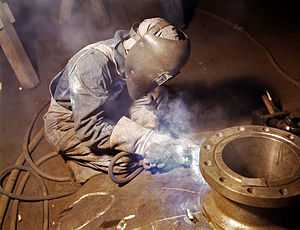Boilermaker

A boilermaker is a trained craftsman who produces steel fabrications from plates and sections. The name originated from craftsmen who would fabricate boilers, but they may work on projects as diverse as bridges to blast furnaces to the construction of mining equipment.[1]
Boilermaking
Many boilermakers are employed in repairing, repiping, and re-tubing commercial steam and hot water boilers used for heating and domestic hot water in commercial buildings and multi-family dwellings. Sometimes these boilers are referred to as pressure vessels. Generally, a pressure vessel is a storage tank or vessel that has been designed to operate at pressures above 15 psi (1.03 bar; 103 kPa). The two main tasks of boilermakers involve using oxy-acetylene gas torch sets to cut or gouge steel plate and tubes, followed by gas tungsten arc welding (GTAW), shielded metal arc welding (SMAW), or gas metal arc welding (GMAW) to attach and mend the cut sections of tubes and steel plates.[2]
R Stamp Welding
Boiler repair in the United States is governed by the National Board of Boiler and Pressure Vessel Inspectors and the ASME under a classification called R Stamp Welding. In order to perform R Stamp welds and repairs, boilermakers are tested and certified in the quality of their weld joints through a rigorous testing procedure. R stamps are issued to companies that have existing ASME code stamps issued for construction and whose QC system covers repairs or follow the guidelines set up by ASME to obtain an R stamp. Welders identify their welds by stamping their identifying welder number adjacent to their completed weld with a set of steel stencils.[3]
Power piping
The trade of Boilermaker evolved from the industrial blacksmith and was known in the early 19th century as a "boilersmith". The involvement of boilermakers in the shipbuilding industry came about because of the changeover from wood to iron as a construction material. It was easier (and cheaper) to utilize the boilermaker's skills to construct the ship as they were already present in the shipyard constructing iron boilers for wooden steamships. This utilization of skills extended to virtually everything that was large and made of iron, or later, steel.
Welding, fitting, and installing the tubes and accessories that attach to the boiler can also be performed by boilermakers, and is governed by the same organizations as R Stamp Welding, except this certification is called Powerpiping certification. The Powerpiping stamp contains two "P"s, the first inverted so that it mirrors the second. Power Piping is governed by ASME Code section B31.1.[4]
Application
Boilermaking, welding, and fitting tubes can be a full-time year round project at powerplants- since stress fractures, leaks, and rust and corrosion cause a continual need for repair or replacement, and power plants often operate at very high steam pressures. Other boilermakers might work seasonally or on an individual project such as re-fitting a boiler in a seagoing vessel, or in the one-time remodeling of a steam plant.
Boiler repair can be a very valuable service since even the smallest steam boilers for dry cleaners, tailor and alterations shops can cost upwards of ten to twenty thousand dollars (US) to replace.
Training
Boilermakers usually go through a formal apprenticeship which includes about four years of paid on-the-job training combined with classroom instruction. Unions and many employers offer these apprenticeships. To become an apprentice, one must be at least 18 years old and have a high school diploma or GED. Attending a trade or technical school combined with employer-provided training can accelerate the learning curve.[5]
Trade unions
The International Brotherhood of Boilermakers, Iron Ship Builders, Blacksmiths, Forgers and Helpers is a labor union
References
- ↑ Bureau of Labor Statistics, US Department of Labor, Occupational Outlook Handbook, 2014-15 Edition, Boilermakers, on the Internet at http://www.bls.gov/ooh/construction-and-extraction/boilermakers.htm (visited January 23, 2014)
- ↑ Bureau of Labor Statistics, US Department of Labor, Occupational Outlook Handbook, 2014-15 Edition, Boilermakers, on the Internet at http://www.bls.gov/ooh/construction-and-extraction/boilermakers.htm (visited January 23, 2014)
- ↑ http://www.nationalboard.org/index.aspx?pageID=115&ID=160
- ↑ https://www.asme.org/products/codes-standards/b311-2012-power-piping
- ↑ Employment and Training Administration, US Department of Labor, O*NET Online, Boilermakers, on the Internet at http://online.onetcenter.org/link/details/47-2011.00 (visited January 23, 2014)